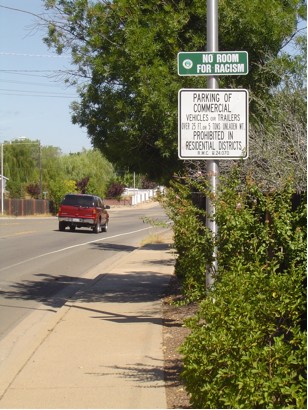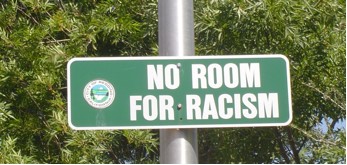By Tom O’Mara, Shasta County Citizens Against Racism
The genesis of the Shasta County Citizens Against Racism (SCCAR) was an incident that occurred in the summer of 1988. In Caldwell Park, the major park then in the city of Redding, a black male and white female standing together were targeted. Someone in a vehicle driving by them yelled racial epithets. Then a gunshot was fired. Fortunately, no one was injured. The case went to trial, and a few local residents troubled by the incident, including SCCAR founding member Fran Brady, longtime civil rights activist Isaac Lowe (featured in the documentary Not In Our Town Northern California,) and a local publisher, David Ledger, decided they would start going to the court hearings as a sort of silent vigil, and because they didn’t want what happened to be swept under the rug.
The case resulted in a conviction and this core group of locals felt like there were enough racially biased incidents happening in Redding that they wanted to form something that was more ongoing and official. So they named themselves Shasta County Citizens Against Racism. (Several years later the group sought and achieved non-profit status.)
I knew Fran Brady from working together, and as SCCAR went on and my relationship with her developed, I became involved. In the early years, a big function of the group was keeping law enforcement on task and getting them to comply with laws like the 1994 Bane Act, which required mandatory reporting of hate crimes. So we were sort of a watchdog presence in the community when a hate crime occurred.
I remember one case involving a man who walked through a predominantly Southeast Asian neighborhood of Redding with a baseball bat or a two by four, breaking windshields and one living room window, and yelling things like “Go back to Asia within two weeks,” “Learn English” and “You’re Not Welcome Here.” We learned that the case was not referred by the Redding Police Department to the District Attorney’s office as a hate crime. I and two other SCCAR members went down to the police department. We met with a lieutenant and made him aware that we were aware of California Penal Code 422.6, expected the police to uphold it, and wanted to know why this particular case was not referred as a hate crime. We were told that the officer responding to the scene was a new recruit from another law enforcement agency who hadn’t been trained in the same way that Redding Police Department recruits were, and we were assured they would update their training of new hires. There were a number of other cases like this that we became involved in – some of them involved cases that were referred, but then not prosecuted by the D.A., and some of them involved incidents that the Sheriff’s Department responded to.
 Over time, little by little, we started to develop some credibility as an organization with experience dealing with hate crimes. I think law enforcement, when there was rumor or an incident, started looking to SCCAR in a preventative way as a resource. While our relationships may have started out in an adversarial way, we started to work together with law enforcement more productively. We really worked on those relationships and tried to approach situations by investigating them thoroughly. Just because someone of color was arrested, it didn’t make it automatically racist. But if we did find something of that nature, we’d jump on it immediately.
Over time, little by little, we started to develop some credibility as an organization with experience dealing with hate crimes. I think law enforcement, when there was rumor or an incident, started looking to SCCAR in a preventative way as a resource. While our relationships may have started out in an adversarial way, we started to work together with law enforcement more productively. We really worked on those relationships and tried to approach situations by investigating them thoroughly. Just because someone of color was arrested, it didn’t make it automatically racist. But if we did find something of that nature, we’d jump on it immediately.It helped that for a time I was working for the Youth Violence Prevention Council, a gang violence prevention nonprofit, and my office was in the Redding Police Department’s investigative unit. At first the officers all looked at me guardedly since I was the only non-sworn personnel there. But that changed, and my experience has been that law enforcement’s level of caring for the community is extremely high. I especially feel that way about the Redding Police Department. Redding is a small community with few resources, which leads to a lot of collaboration. But I think there is some application to bigger cities as well. I think police would much rather prevent situations than deal with consequences down the road, and they are interested in information and relationships.
 I remember when I got involved with Redding’s “No Room for Racism” sign campaign. We wanted the city and county to endorse it and approve signs with the message to be placed around town and at the city limits. One of the first things we did was start a petition. We had about 400 signatures that we presented to the Board of Supervisors, and the first signatures on the petition were by the police chief and the sheriff. (The City of Redding has posted five "No Room For Racism" signs with the city seal, and there are now a total of 75 similar signs that have been posted by other communities at area school sites, hospitals, and other facilities.)
I remember when I got involved with Redding’s “No Room for Racism” sign campaign. We wanted the city and county to endorse it and approve signs with the message to be placed around town and at the city limits. One of the first things we did was start a petition. We had about 400 signatures that we presented to the Board of Supervisors, and the first signatures on the petition were by the police chief and the sheriff. (The City of Redding has posted five "No Room For Racism" signs with the city seal, and there are now a total of 75 similar signs that have been posted by other communities at area school sites, hospitals, and other facilities.)I’ve learned there is a shared interest with law enforcement in the betterment of and the safety of the community. And I think law enforcement understands that if they can do something on the preventative end, it’ll help them and help the community. So I encourage people to initiate contact with law enforcement, whether it’s a police captain or the chief of police or a beat officer, and to share their concerns and ask if there is anything law enforcement may be able to do to be of help.
Tom O’Mara is media spokesperson for the Shasta County Citizens Against Racism. He is retired from a variety of social service and violence prevention jobs in the Redding area, and counts his employment at Glide Memorial Church in San Francisco as invaluable organizing experience. He and his wife Alice Wilkinson are owner-builders of a solar home in Olinda, CA. Tom is a graduate of UC Berkeley, which followed a brief stint as a basketball player for the University of Notre Dame.
Comments
Racism in Reddng
~~
I hope the racism has improved since my wife and I went through there in 2006. On vacation we stopped there for lunch and went to Chevys. I am Mexican and my wife is white (English/Dutch). When we walked into the restaurant, a world of eyes was upon us. It took a while to be seated and we noted that others, (white couples) were seated before us. Waiters and waitresses seemed to pass us by, and after ten minutes, I finally signaled a waitress that we had not been given our menus to order. She seemed annoyed and kind of threw the menus on the table. We then looked around and noted that I was the only Mexican or Hispanic looking person in the restaurant, other than two busboys. The waitress never returned to take our order, so I caught the attention of a man who seemed like a manager. After we saw him talking to our waitress, he himself ended up being our waiter for the remainder of our dinner. Apparently the waitress didn’t want to serve us.
As I said, I hope the racism in this town has improved….
David Dothard
Im curious if a bi-racial man would get treated different in Shasta than a white man? When David Dothard got a charge last year in Shasta, it was supposedly ccw. He ran from police and left state in May and was eventually arrested in Alabama in August of this year. He was extradited back to california and now has 4 felonies and 5 misdemeanor charges.
The most racist place on earth
There is plenty of room for racism in this county. In the short time I've lived in this county, I've experienced more racist than in a lifetime of anywhere else. This county is not a safe place for any minority. The movie Mississippi Burning is pretty much how Shasta County is today.